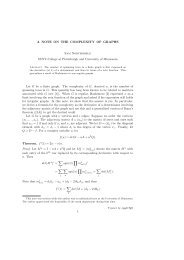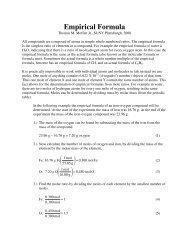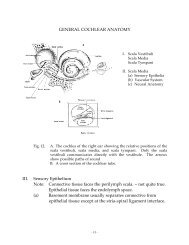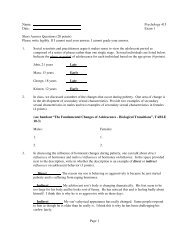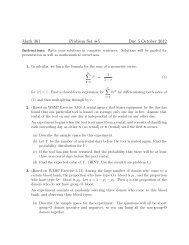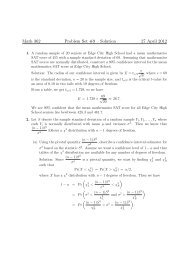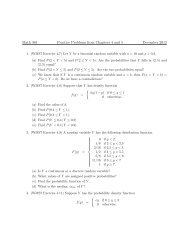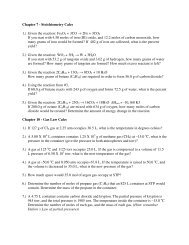266 J. ROSEN, J. REITER, AND P. OROSANvention and were asked to identify and prepare themselves <strong>for</strong> impendinghigh-risk situations.Measures<strong>Body</strong> <strong>Dysmorphic</strong> Disorder Examination (Version 3.1). This is a32-item semistructured clinical interview designed to measure the cognitiveand behavioral symptoms of body dysmorphic disorder (Rosen &Reiter, 1994). It taps into self-consciousness and preoccupation withphysical appearance, overvalued ideas about the importance of appearancein self-evaluation, avoidance of social situations or exposure of theappearance defects, and body camouflaging and body checking behavior.The BDDE had acceptable test-retest reliability (r = .94), internalconsistency (r = .95), and concurrent validity with other body imagequestionnaires (rs = .68 to .83). The interrater reliability <strong>for</strong> the totalscore of independent interviews was r = .89, and the kappa measure ofindependent diagnostic agreement with the BDDE was .81.For the present study, the BDDE was scored <strong>for</strong> the total severity ofHDD symptoms and <strong>for</strong> the presence or absence of BDD according tothe recommended set of cutoff scores.<strong>Body</strong> Shape Questionnaire. This is a body image questionnaire(Cooper, Taylor, Cooper, & Fairburn, 1987) that measures desire to loseweight, body dissatisfaction, and feelings of low self-worth in connectionwith weight and shape. The coefficients of internal consistency,test-retest reliability, and concurrent validity with other measures ofbody satisfaction are adequate: rs = .97, .88, and .66, respectively.Multidimensional <strong>Body</strong> Self-Relations Questionnaire (MBSRQ) AppearanceEvaluation scale (Brown, Cash, & Mikulka, 1990). Of theseven MBSRQ scales, only the Appearance Evaluation scale was administered.Appearance Evaluation consists of 7 ratings of feelings of physicalattractiveness or unattractiveness and satisfaction or dissatisfactionwith one's looks. The rs <strong>for</strong> test-retest reliability and internal consistencyare .91 and .88. Concurrent validity with another measure ofbody satisfaction is .66.Brief Symptom Inventory (Derogatis & Spencer, 1982). We calculatedthe Global Severity Index, which is an index of overall psychologicaldistress. Test-retest reliability is .90 and internal consistency rangesfrom .71 to .85. Validity coefficients with the Minnesota MultiphasicPersonality Inventory are above .30.Rosenberg Self-Esteem Scale. This is a measure of global self-esteem(Rosenberg, 1979) in vol ving ratings of attitudes regarding generalself-worth. The measure has acceptable test-retest reliability (.77) andinternal consistency (.89). The scale is significantly correlated with peerratings (r= .32; Demo, 1985).PretreatmentResultsStatistical tests per<strong>for</strong>med on values of age, education, bodymass index, marital status, body image measures, psychologicalsymptoms, and self-esteem revealed no significant differencesbetween the experimental conditions at baseline.Adherence, Credibility, and SatisfactionNo subject dropped out of treatment. The cancellation policyproved successful as treatment subjects attended all eight sessions,(i.e., there was 100% attendance). The only deviationfrom the planned <strong>for</strong>mat was that two subjects received one individualsession each because the remainder of group participantswere unable to agree on an alternative meeting time. Ateach session subjects returned a homework completion checklistand the therapists reviewed each assignment. Of the 41homework assignments, subjects completed an average of 86%(SD = 15). Twenty-two percent completed less than 80% ofassignments, but none completed less than half. All subjectscompleted the posttreatment (or postwaiting) evaluation. Onetreatment subject refused to return <strong>for</strong> the follow-up evaluation.No treatment subject began psychological treatment outside ofthe program during the treatment or follow-up phase. One notreatmentsubject started psychotherapy elsewhere 2 weeksprior to the posttreatment assessment.In the second therapy session, we asked subjects to rate on ascale of 1 to 7 their expectation to benefit from this therapy; themean was 5.46 (SD = .90). After treatment ended, their ratingof satisfaction with treatment was 5.73 (SD = 1.22) and thedegree to which they would recommend this program to otherswas 6.27 (SD = 1.31). Eighty percent said they would recommendthe program. These ratings and the percent of homeworkcompletion were not significantly correlated with changes onthe body image measures.To assist therapist adherence to the treatment protocol, therapistsfollowed a detailed session-by-session manual. Con<strong>for</strong>mityalso was simplified by the fact that a main focus of eachsession was debriefing and preparing <strong>for</strong> the homework assignments,which were fairly standard <strong>for</strong> all subjects. Finally, thethree therapists met weekly to review each case and ensure adherenceto the protocol.Differences Between Conditions at PosttreatmentThe difference between the treatment and no-treatment conditionsat posttreatment on the five measures of body imageand psychological adjustment (see Table 1) was examined in abetween-groups multivariate analysis of covariance, controlling<strong>for</strong> pretreatment scores. The main effect <strong>for</strong> group was significant,F(5, 43) = 20.01, p = .000, indicating that the subjectswho received treatment were much improved compared withthe no-treatment subjects.Differences between groups at posttreatment on individualdependent variables controlling <strong>for</strong> pretreatment were examinedusing the univariate analyses of covariance derived fromthe multivariate analysis. <strong>Cognitive</strong> behavior therapy subjectswere significantly improved on all measures at posttreatmentcompared with the no-treatment subjects: <strong>Body</strong> <strong>Dysmorphic</strong>Disorder Examination, F( 1, 47) = 65.80, p = .000; MBSRQAppearance Evaluation scale, F( 1,47) = 45.57,p = .000; <strong>Body</strong>Shape Questionnaire, F( 1,47) = 81.61, p = .000; psychologicalsymptoms, F( 1, 47) = 13.53, p = .001; and self-esteem, F( 1,47)= 12.61, p= . 001.Differences Over Time <strong>for</strong> <strong>Cognitive</strong> Behavior <strong>Therapy</strong>ParticipantsA within-subject multivariate analysis of variance (MANO\A)using the pre-, posttreatment, and follow-up assessments resultedin a main effect <strong>for</strong> time, F( 10, 16) = 11.09, p = .000, indicatingthat treatment subjects were significantly improved over time.Univariate analyses derived from the MANOVA resulted in sig-
BODY DYSMORPHIC DISORDER 267Table 1Means and Standard Deviations of Dependent Variables by Treatment Phase<strong>Cognitive</strong>-behaviortherapy(n = 27)'No treatment(n = 27)MeasureMSDMSD<strong>Body</strong> <strong>Dysmorphic</strong> Disorder ExamPretreatmentPosttreatmentFollow-upMBSRQ Appearance Evaluation ScalePretreatmentPosttreatmentFollow-up<strong>Body</strong> Shape QuestionnairePretreatmentPosttreatmentFollow-upBrief Symptom InventoryPretreatmentPosttreatmentFollow-upRosenberg Self-Esteem ScalePretreatmentPosttreatmentFollow-up83.941.139.91.973.082.99133.587.588.0.92.57.5025.129.930.014.816.921.3.42.59.8219.220.422.8.48.46.405.65.65.2Note. MBSRQ = Multidimensional <strong>Body</strong> Self-Relations Questionnaire.• At follow-up, N = 26.89.983.2—1.861.85—142.7142.4—1.01.0—23.924.9—16.119.7—.39.59—24.626.3—.53.60—4.75.9—nificant main effects <strong>for</strong> time <strong>for</strong> each variable (df= 2,49; p =.000): <strong>Body</strong> <strong>Dysmorphic</strong> Disorder Examination, F(2, 49) =69.02, p = .000; MBSRQ Appearance Evaluation Scale, F(2,49)= 31.89, p = .000; <strong>Body</strong> Shape Questionnaire, F( 2,49) = 57.55,p = .000; psychological symptoms, F(2, 49) = 17.59, p = .000;and self-esteem, F(2,49) = 28.23, p = .000.Post hoc paired comparisons controlling <strong>for</strong> family-wise errorindicated that treatment subjects improved significantly onall measures from pre- to posttreatment and pretreatment tofollow-up at p = .000, except that the pre- to posttreatmentchange in psychological symptoms was significant at p = .003.There were no significant differences between posttreatmentand follow-up.Rates of Clinically Significant ImprovementTo be considered clinically improved, a subject had to (a)no longer meet the diagnostic criteria on the <strong>Body</strong> <strong>Dysmorphic</strong>Disorder Examination and (b) have a score lower on the BDDEafter treatment than her pretreatment score minus 2 standarderrors of measurement. Using Speer's recommendation <strong>for</strong> calculatingclinically significant change (1992), we centered thisconfidence interval on an estimate of the subject's "true" pretreatmentscore, which adjusted <strong>for</strong> regression to the mean. Twosubjects in the no-treatment condition (7.4%) met these criteria<strong>for</strong> improvement after the waiting period. Of the 27 cognitivetherapy subjects, 22 were clinically improved at posttreatment(81.5%) and 20 of 26 were improved at follow-up (76.9%).Three of the five unimproved treatment subjects at posttreatmentwere clinically improved at follow-up, and four "relapsed,"that is, no longer scored in the clinically improvedrange at follow-up.Discussion<strong>Cognitive</strong> behavioral body image therapy proved to be aneffective treatment <strong>for</strong> body dysmorphic disorder. The total severityof BDD symptoms of therapy subjects decreased to thenormal range on the <strong>Body</strong> <strong>Dysmorphic</strong> Disorder Examination(.4 SD above the mean <strong>for</strong> a community sample, Rosen &Reiter, 1993) and the majority of patients no longer met thediagnostic criteria <strong>for</strong> BDD. Preoccupation with appearanceand body dissatisfaction were improved on the other two measuresof body image, the <strong>Body</strong> Shape Questionnaire andMBSRQ Appearance Evaluation scale. The means on thesescales decreased from the clinically severe range to the normalrange. Although other psychological symptoms were nottargeted in therapy, on average the total severity of symptomsand global self-esteem improved to the normal range.Treatment was not uni<strong>for</strong>mly effective; a significant minorityof subjects still had BDD at the follow-up. We were unable toidentify any subject characteristics that distinguished these patientsfrom others. They did not differ in demographics or severityof body image and psychological symptoms at baseline.However, in regard to the therapy <strong>for</strong>mat, our impression wasthat some patients might have benefitted from longer treatmentand more intensive, supervised exposure response preventionoutside of the clinic. Also, it is possible that some subjects might



